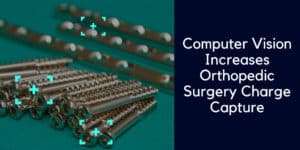“Post-care item charges are being mishandled, leading to significant financial losses” This is something we hear from customers all the time. And they’re right—studies show that 5-20% of potential revenue is lost due to missed charges, particularly for high-value items.
Let’s take a scenario involving a procedural area with five rooms—IR, Cath labs, EP labs—where the average item cost is $700. If two items are missed weekly, and this happens in all five rooms, the missed charges per week amount to $4,200. Annually, this leads to missed charges of $218,400. And this is just one department, in one year. And… only two missed charges per week. Let’s be honest—it’s usually more. The potential revenue lost is staggering.
The Problem: Post-Case Charge Errors
Healthcare providers face several challenges with item documentation after procedures. A major part of high-cost implants includes bill-only items, which are primarily logged manually. Common issues include:
Manual Entry and Tracking Errors: Clinicians and staff often rely on manual methods or outdated charge master data to log high-cost items, leading to missed or incorrect charges and discrepancies.
Product Specification and New Item Issues: Changes in product specifications, packaging, or GTINs may not be reflected in hospital item master listings. Additionally, substitutes, bill-only items, and off-contract products may not be listed at all, resulting in unlogged charges.
Lack of Standardization Across Departments: Different departments may refer to the same product by various names, causing duplicate entries, failed searches, and delays in administration.
Workflow Bottlenecks: The reliance on manual charge reconciliation post-case creates delays, increases administrative workload, and impacts operational efficiency.
Spoiler: Addressing these gaps with AI-powered technology can significantly reduce losses and improve financial outcomes.

The True Cost of Missed Charges in IR, Cath Labs, and EP Labs
High-value procedural areas like Cath Labs, Interventional Radiology (IR), and Electrophysiology (EP) are especially vulnerable to inefficiencies, leading to cascading effects on both revenue cycles and supply chain operations.
Implications of Charge Errors
The consequences of post-case charge errors can be divided into two major categories:
1. Impact on Revenue Cycle:
Revenue Leakage: Studies show that up to 20% of potential revenue is lost due to missed charges, particularly for high-value items like implants.
Underpayments and Claims Denials: Missing or incorrect charges can result in underbilling, reduced reimbursement rates, or outright claims denials.
Audit Resilience: Discrepancies in charge documentation increase the risk of regulatory scrutiny, audits, and penalties, jeopardizing financial and reputational standing.
2. Impact on Operational Efficiency and Case Costing:
Operational Inefficiencies: Manual reconciliations increase labor costs, detract from staff productivity, and divert focus from patient care.
Waste and Inventory Mismanagement: Poor charge capture disrupts inventory accuracy, causing stock shortages, over-ordering, or unnecessary waste.
Labor and Workflow Bottlenecks: Manual processes create delays, increase administrative workload, and hamper efficient resource allocation.
The Solution: AI-Powered Cameras and Computer Vision
Snap&Go is an AI-powered camera solution, that addresses these critical gaps by automating processes and enhancing visibility across workflows:
- Real-Time Tracking: AI-powered cameras track item usage during procedures, ensuring every item—from implants to disposables—is logged accurately.
- Error Prevention and Proof of Use: These systems reconcile mismatches in real-time and capture a digital image of each item as proof of use for claims submission, ensuring audit resilience and minimizing disputes.
- Charge Master Integration with Revenue Codes: Cameras link products to the correct revenue codes and procedures, seamlessly integrating with EHR, billing, and inventory systems for accurate reimbursement.
- Non-Disruptive Workflow: Any mismatches are resolved by the system’s AI without interrupting the nurse’s workflow, ensuring minimal disruption.
- 100% Validated Charge Data: The system populates fully validated data into the charge master and billing system, increasing reimbursement rates by 15-20%.
Case Study Example
A leading hospital implemented an AI-powered camera system in its Cath Lab, IR and EP labs. Within two years, they saw a reduction in claims denials caused by incomplete or inaccurate implant documentation, an increase in charge capture accuracy for high-value implants, and a reduction in revenue leakage, equating to approximately 1,823,300$ in recovered revenue. Plus a significant time savings for administrative staff, allowing them to focus on patient care.
The challenges of post-case charge errors demand innovative solutions. AI-powered cameras and computer vision technologies are not just tools; they are transformative enablers for healthcare providers aiming to enhance charge accuracy, streamline workflows, and improve financial outcomes.
For revenue cycle and supply chain executives, the message is clear: investing in these advanced technologies can bridge critical gaps, drive efficiency, and secure the future of healthcare operations.

Conclusion
The challenges of post-case charge errors demand innovative solutions. AI-powered cameras and computer vision technologies are not just tools; they are transformative enablers for healthcare providers aiming to enhance charge accuracy, streamline workflows, and improve financial outcomes.
For revenue cycle and supply chain executives, the message is clear: investing in these advanced technologies can bridge critical gaps, drive efficiency, and secure the future of healthcare operations.






